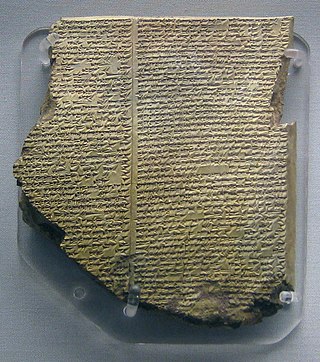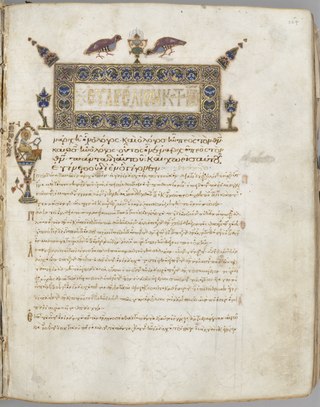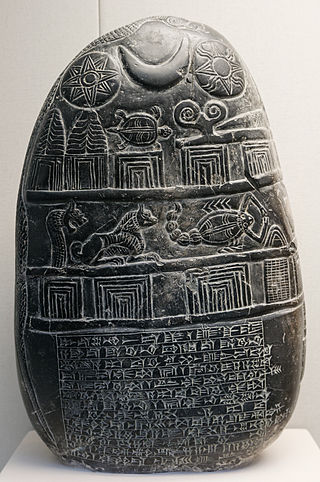The word anathema has two main meanings. One is to describe something or someone that is hated or avoided. The other is to refer to a formal excommunication by a church. These meanings come from the New Testament, where an anathema was a person or thing cursed or condemned by God. In the Old Testament, an anathema was something or someone dedicated to God as a sacrifice, or cursed and separated from God because of sin. These represent two types of setting apart, one for devotion, the other for destruction.

A scribe is a person who serves as a professional copyist, especially one who made copies of manuscripts before the invention of automatic printing.
Akkadian literature is the ancient literature written in the Akkadian language in Mesopotamia during the period spanning the Middle Bronze Age to the Iron Age.

The Epic of Gilgamesh is an epic poem from ancient Mesopotamia. The literary history of Gilgamesh begins with five Sumerian poems about Bilgamesh, king of Uruk, dating from the Third Dynasty of Ur. These independent stories were later used as source material for a combined epic in Akkadian. The first surviving version of this combined epic, known as the "Old Babylonian" version, dates back to the 18th century BC and is titled after its incipit, Shūtur eli sharrī. Only a few tablets of it have survived. The later Standard Babylonian version compiled by Sîn-lēqi-unninni dates from the 13th to the 10th centuries BC and bears the incipit Sha naqba īmuru. Approximately two-thirds of this longer, twelve-tablet version have been recovered. Some of the best copies were discovered in the library ruins of the 7th-century BC Assyrian king Ashurbanipal.

Marduk was a god from ancient Mesopotamia and patron deity of the city of Babylon who eventually rose to power in the First Millennium BCE. In the city of Babylon, Marduk was worshipped in the temple Esagila. His symbol is the spade and he is associated with the Mušḫuššu.

An illuminated manuscript is a formally prepared document where the text is decorated with flourishes such as borders and miniature illustrations. Often used in the Roman Catholic Church for prayers, liturgical services and psalms, the practice continued into secular texts from the 13th century onward and typically include proclamations, enrolled bills, laws, charters, inventories and deeds.

In publishing, a colophon is a brief statement containing information about the publication of a book such as an "imprint".

The Book of Mulling or less commonly, Book of Moling, is an Irish pocket Gospel Book from the late 8th or early 9th century. The text collection includes the four Gospels, a liturgical service which includes the "Apostles' Creed", and in the colophon, a supposed plan of St. Moling's monastery enclosed by two concentric circles.

Enūma Eliš is the Babylonian creation myth. It was recovered by English archaeologist Austen Henry Layard in 1849 in the ruined Library of Ashurbanipal at Nineveh. A form of the myth was first published by English Assyriologist George Smith in 1876; active research and further excavations led to near completion of the texts and improved translation.

Nabu is the ancient Mesopotamian patron god of literacy, the rational arts, scribes, and wisdom.

The Textus Roffensis, fully titled the Textus de Ecclesia Roffensi per Ernulphum episcopum and sometimes also known as the Annals of Rochester, is a mediaeval manuscript that consists of two separate works written between 1122 and 1124. It is catalogued as "Rochester Cathedral Library, MS A.3.5" and as of 2023 is currently on display in a new exhibition at Rochester Cathedral, Rochester, Kent. It is thought that the main text of both manuscripts was written by a single scribe, although the English glosses to the two Latin entries were made by a second hand. The annotations might indicate that the manuscript was consulted in some post-Conquest trials. However, the glosses are very sparse and just clarify a few uncertain terms. For example, the entry on f. 67r merely explains that the triplex iudiciu(m) is called in English, ofraceth ordel.
Marc Drogin was an American writer and illustrator.
Ancient Semitic religion encompasses the polytheistic religions of the Semitic peoples from the ancient Near East and Northeast Africa. Since the term Semitic itself represents a rough category when referring to cultures, as opposed to languages, the definitive bounds of the term "ancient Semitic religion" are only approximate.

Ištaran was a Mesopotamian god who was the tutelary deity of the city of Der, a city-state located east of the Tigris, in the proximity of the borders of Elam. It is known that he was a divine judge, and his position in the Mesopotamian pantheon was most likely high, but much about his character remains uncertain. He was associated with snakes, especially with the snake god Nirah, and it is possible that he could be depicted in a partially or fully serpentine form himself. He is first attested in the Early Dynastic period in royal inscriptions and theophoric names. He appears in sources from the reign of many later dynasties as well. When Der attained independence after the Ur III period, local rulers were considered representatives of Ištaran. In later times, he retained his position in Der, and multiple times his statue was carried away by Assyrians to secure the loyalty of the population of the city.
Aššur-rēša-iši I, inscribed maš-šur-SAG-i-ši and meaning “Aššur has lifted my head,” ruled 1132–1115 BC, son of Mutakkil-Nusku, was a king of Assyria, the 86th to appear on the Assyrian King List and ruled for 18 years. The Synchronistic King List and its fragmentary copies give him as a contemporary of the Babylonian kings Ninurta-nādin-šumi, Nebuchadnezzar I and Enlil-nādin-apli, although the last of these is unlikely per the commonly accepted chronology.

Zarpanitu was a Mesopotamian goddess regarded as the spouse of Marduk. Not much is known about her character, though late sources indicate that she was associated with pregnancy and that she could be assigned similar roles as her husband, including that of queen of the gods. She was originally worshiped in Zarpan, a village near Babylon, though the latter city itself also served as her cult center.

Nisaba was the Mesopotamian goddess of writing and grain. She is one of the oldest Sumerian deities attested in writing, and remained prominent through many periods of Mesopotamian history. She was commonly worshiped by scribes, and numerous Sumerian texts end with the doxology "praise to Nisaba" as a result. She declined after the Old Babylonian period due to the rise of the new scribe god, Nabu, though she did not fully vanish from Mesopotamian religion and attestations from as late as the neo-Babylonian period are known.

The Cedar Forest is the glorious realm of the gods of Mesopotamian mythology. It is guarded by the demigod Humbaba and was once entered by the hero Gilgamesh who dared cut down trees from its virgin stands during his quest for fame. The Cedar Forest is described in Tablets 4–6 of the Epic of Gilgamesh.
An = Anum, also known as the Great God List, is the longest preserved Mesopotamian god list, a type of lexical list cataloging the deities worshiped in the Ancient Near East, chiefly in modern Iraq. While god lists are already known from the Early Dynastic period, An = Anum most likely was composed in the later Kassite period.














